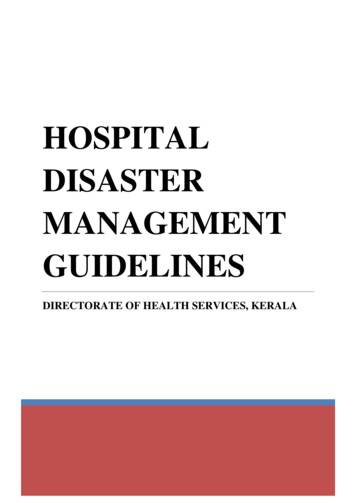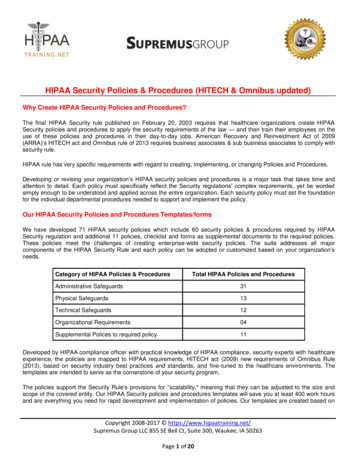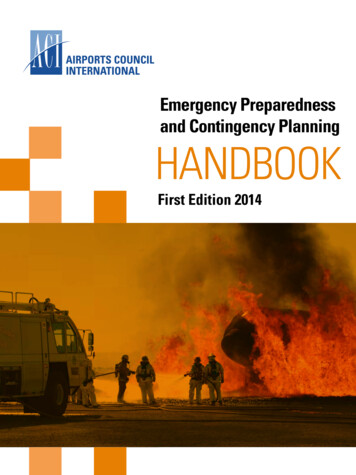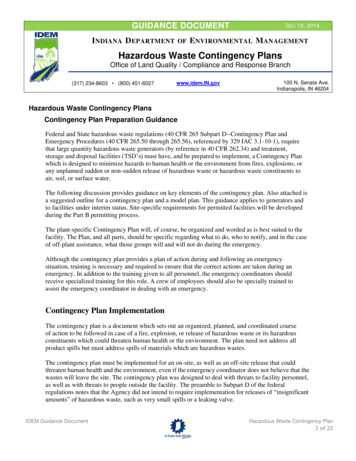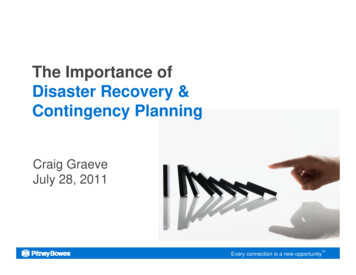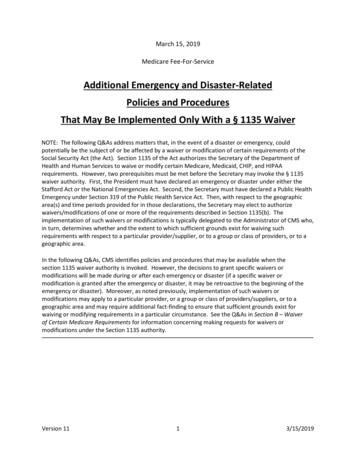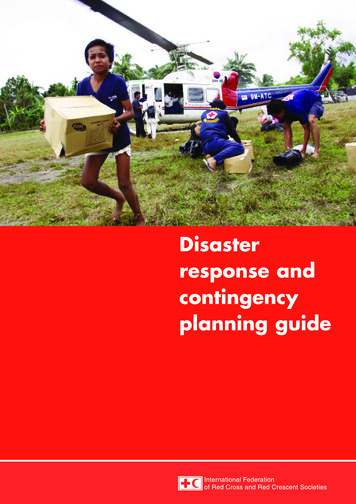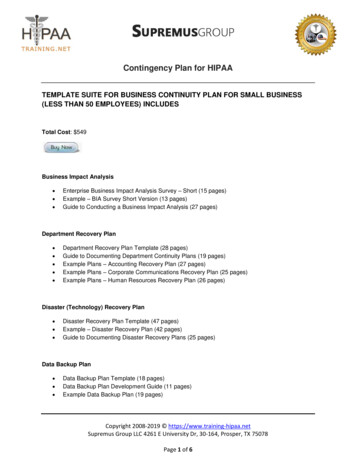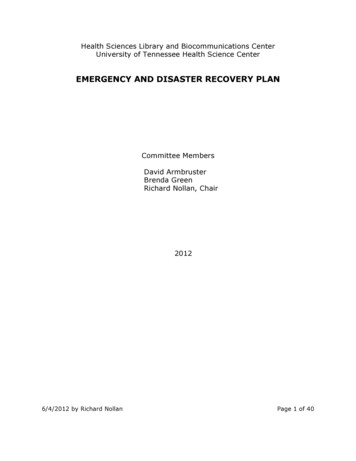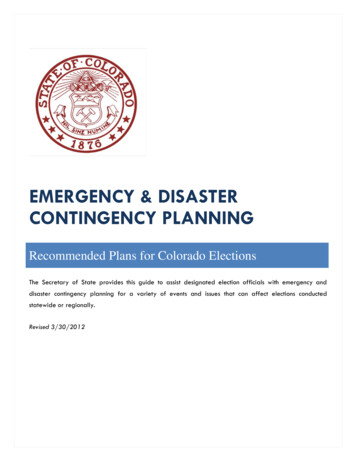
Transcription
EMERGENCY & DISASTERCONTINGENCY PLANNINGRecommended Plans for Colorado ElectionsThe Secretary of State provides this guide to assist designated election officials with emergency anddisaster contingency planning for a variety of events and issues that can affect elections conductedstatewide or regionally.Revised 3/30/2012
INTRODUCTION . 4IDENTIFYING AND ASSESSING CONTINGENCIES . 4Natural Disasters and Severe Weather . 5Manmade Disasters and Other Risks . 5DEVELOPING AND IMPLEMENTING CONTINGENCY PLANS . 5MAKING THE RIGHT CONTACTS . 6State, County and Local Emergency Management Offices . 6Other Local Agencies and Departments . 6STAY INFORMED . 7Colorado Emergency Alert System . 7SMS/Text Alert and Mobile Emergency Alert Systems . 7Weather Service and Road Condition Alerts . 7Roadway maintenance and Access . 8BE PREPARED . 8Communication Plan . 8Contact List for Mission-Critical Staff and Agencies . 8Communication & Agreements with Neighboring Jurisdictions . 8Communication with Power, Telephone, internet, and Water Companies. 8Media Communication Planning . 8Communications Outage Plan . 9Training & Testing . 9Power-Failure Procedures . 10Emergency Supplies. 10Relocation or Consolidation of Polling Places . 10Identify and Establish Alternate Polling Places . 10Relocation Planning Tips . 10Securing Equipment and Supplies . 11Polling Place Security . 11Page 2 of 22
Bomb Threat Protocol . 11Telephone Bomb Threat. 11Written Bomb Threat . 12Determine Alternative Office Space . 12Evacuation of DEO Office . 12Inclement Weather After the Polls Open . 12Scripted Phone Message . 13Designation of On-Call Pollworkers . 13Designation of Runners or Troubleshooters . 13Flu Season & Pandemic Planning . 13Long Lines . 14Shortage of Poll Workers . 14Shortage of Ballots and/or Supplies . 14Equipment Issues . 15Polling Place Not Open . 15HELPFUL RESOURCES AND LINKS . 16Management Information . 16Natural Disasters and Severe Weather . 16Manmade Disasters and Other Risks . 17Flu Season and Pandemic Planning – Health Resources . 18Document Preservation . 19EXAMPLE CHECKLISTS . 20Example Polling Place Checklists . 20Example Polling Place Relocation Procedures Checklist . 21Example Management Plan – Fire in Voting System Warehouse . 22Page 3 of 22
EMERGENCY &DISASTERCONTINGENCYPLANNING RECOMMENDED PLANS FORCOLORADO ELECTIONS INTRODUCTIONThis document has been prepared after research regardingrecommendations from the U.S. Election AssistanceCommission as well as various plans and laws from stateswho have previously implemented procedures relating toemergency and disaster contingency plans. This documentis not fully comprehensive. Counties should use thisdocument as a starting point for discussion of this topic.The objective of this guide is to help ensure that countyclerk and recorders make effective plans and preparationsand are ready for, can respond to, and can recover fromemergency situations to maintain the integrity of theelections process. Establishing and implementingemergency plans will help ensure that polling places willbe properly equipped to handle an emergency on ElectionDay, however, please be sure not to limit planning andpreparation to just Election Day worst case scenarios.An effective emergency plan requires research, discussionand making choices today about solutions for the future.By using the resources that are currently available and bydeveloping new and improved resources, the integrity ofelections can be protected and emergency situationsaddressed or even prevented.At a minimum, an emergency preparedness plan shouldaddress the following: Identifyingcommoncontingencies,Compiling information,andorResponse design,Technical and communication needs,Resources and support,Establishing and maintaining an ongoingpartnership with state, county, and localofficials/emergency contacts,Process to deploy and facilitate emergencycommunications during a disaster,Ability of each of the groups to respond to anemergency,Process to activate emergency judges or supplies,Level of security that would be required torespond to an emergency,Back-up planning, andTraining for county clerk and recorder officepersonnel and election judgesPlease note, a good emergency plan should be reviewed,refined and updated regularly to be sure it remainseffective. We recommend updating your county plan atleast once every two years before the general election.IDENTIFYING AND ASSESSINGCONTINGENCIESEmergency and disaster contingency planning starts withconsidering the types of situations that can disrupt orimpede elections in your county. Identifying andassessing common emergencies and disasters is essentialfor planning how to respond and minimize the affect onelections.Identify the top five most probable problems that mightoccur regardless of whether the event has ever actuallyoccurred. Once these events are identified, the next stepinvolves developing an action plan specific to eachemergency scenario and establishing procedures to befollowed.This section will introduce some of the common risks andsituations that may occur and provides links to resourcesfor additional information.possiblePage 4 of 22
NATURAL DISASTERS AND SEVEREWEATHERDEVELOPING AND IMPLEMENTINGCONTINGENCY PLANSCommon Colorado risks:When developing an action plan, remember to considerand address the following: Extreme heatWinter storms and extreme coldAvalancheThunderstorms and lightningFloodsLandslide and debris flowEarthquakesWildfiresTornadoes Links to additional informationand guidance for specificnatural disaster and severeweather incidents is availableon page 16. Response and communication structureo Communication networko Contact informationo How to notify local emergencyresponse, county, state and othersupporting organizationso How to notify electors of an alterationin the normal election processo Changing the list of those involved asthe emergency changeso Media communication Backup plansMANMADE DISASTERS AND OTHERRISKSElections may be disrupted by manmade disasters or otherrisks as well and should be accounted for in an emergencyplan.oExamples include: Terrorist hazardso Explosionso Biological threato Chemical threatTechnological and accidental hazardso Blackoutso Hazardous materials incidents Influenza pandemic Medical Emergencies Pests/infestationsChain of commandEmergency reporting proceduresEmergency managementCriteria to activate or terminate an emergencyplanSituation assessmento Emergencies can occur pre-election,during the election, and post-election.Consider all three stagesBackup important files and records thatyou can access Training and directions for election judges andstaff What resources are requiredConsider sharingjurisdictions.Links to additional information and resources areavailable on page 17.Page 5 of 22yourplanwithneighboring
MAKING THE RIGHT CONTACTSTip!Action Plans Should: Identify your top five most likelyoccurrences. Have written procedures on hand andeasily accessible. Be reviewed at least annually, butmore often as needed. Be shared with key staff prior toElection DaySTATE, COUNTY AND LOCALEMERGENCY MANAGEMENT OFFICESContact your local and/or state Emergency Managementoffices to review existing contingency plans and otherinformation. These offices may have existing plans forlocal or state emergencies not specifically related to theconduct of elections, but which contain valuableinformation about resources that may be available toDEOs.To develop a detailed and comprehensive response andmanagement plan, use the following outline as a guide:1.Set a goal: the general end result you would likea contingency plan to achieve2.Define the purpose: refers to the scope of thecontingency plan3.Specify objectives: Specific outcomes thatsupport and help achieve the goal(s) of thecontingency plan. Clear, measurable, achievable,realistic, and time-bound.4.Develop an action plan: speak to the goal andobjectives you have established; each action stepshould relate back to a particular objective(s).Define staff, budget, time, training needs,resources needed. Establish taskforce and/orcommunity partners.5.Implement action plan: implement the ss how effective the action planwas and how to improve for next time.Please see page 22 for an example management planconcerning a fire in the voting system warehouse.Source: EAC Election Management Guidelines.When contacting Emergency Management offices, DEOsmay also wish to discuss options currently available andthe need for further contact. Emergency Managementoffices can be a wealth of information and have thenecessary skills, contacts, and sometimes resources, toassist DEOs with formulating a local plan. It isrecommended that the DEO establish a “Go-To” contactperson in the event an emergency occurs.OTHER LOCAL AGENCIES ANDDEPARTMENTSWork with other county and local agencies, such as theSheriff’s Office or Police Department, Department ofTransportation, Road and Bridge Department, andCommissioners’ or City Council Offices, to identifyresources that may be quickly allocated when respondingto emergencies or disasters. Such events may includeseverely inclement weather thereby creating a need todeploy four-wheel drive vehicles to polling places,provisions for restocking polling places when electionsupplies are low or gone, and monitoring of polling placesecurity.Often, local law enforcement has the ability to dispatch orassign officers to closely watch polling places byregularly driving by locations and ensuring that officersare stationed within close proximity in case an eventrequiring intervention occurs. The Board of CountyCommissioners and/or City Councils can be instrumentalin coordinating such activities and ensuring necessaryresources are allocated.Page 6 of 22
SMS/TEXT ALERT AND MOBILEEMERGENCY ALERT SYSTEMSTip!Identify your contacts as early aspossible. Do not wait until the electionis just around the corner.In advance of Election Day, establish which jurisdictioneach polling location is in (i.e. city police, county sheriff,city department of transportation, county road and bridgedepartment etc.) so the correct agency can be contactedquickly in the event of an emergency. Your county GISstaff may be extremely useful with this process. It isrecommended that the DEO establish a “Go-To” contactperson should an emergency occur. DEOs may wish toenter into intergovernmental agreements with theseagencies to outline duties and responsibilities. Considerpolitely reminding your emergency contacts on ElectionDay to be alert.The Colorado Division of Emergency Management, adivision of the Colorado Department of Local Affairs(DOLA), provides a list of County-level emergencymanagement alert systems in Colorado that support text,SMS, email or mobile alert systems. For moreinformation, visit the following links:Tip!Establish a “Go-To” person for everyagency on your contact list. Pick peopleyou can rely on to get the job done. Division of Emergency Management /CBON/1251590375261 Local information sourcesList of county-level emergency managementwebsites, telephone (office and 24 hour), emailsand sms/txt alert systems in Coloradohttp://www.coemergency.com/p/sources.html COEmergency Mgmt Twitter Feedhttp://twitter.com/#!/coemergency COEmergey Facebookhttp://www.facebook.com/COEmergencyWEATHER SERVICE AND ROADCONDITION ALERTSSTAY INFORMEDCOLORADO EMERGENCY ALERTSYSTEMThe Colorado EAS is a nationwide method of alerting thepublic to natural and manmade disasters. All broadcaststations and cable systems participate in EAS tests andactivations. The system is considered the fastest and mostreliable way to alert large areas or isolated locations oflife threatening emergencies.The National Oceanic andAtmosphericAdministration’s NationalWeather Service websiteprovides alerts currently ineffect for Colorado and isnormally updated every two-three minutes. For moreinformation, click the following links: NOAA National Weather Servicehttp://www.nws.noaa.gov/ Watches, Warnings or .php?x 1 Colorado County Forecast RSS Feed Listinghttp://alerts.weather.gov/cap/co.php?x 3State and local area emergency alert system plans andprocedures are also available online at: State ostate plan.htm Local olocal plans.htmAdditional resources include:General information about the Colorado EAS is availableat: www.startcolorado.com/eas/.Page 7 of 22 Severe Weather Alert Systemhttp://www.swasalert.com/for
National Weather Service - Colorado RSSFeedhttp://alerts.weather.gov/cap/co.php?x 0CDOT – Road Conditions - Twitter Feedhttp://twitter.com/#!/coloradodotROADWAY MAINTENANCE ANDACCESSCoordinate with local Road and Bridge Departments toplan and prepare for weather, emergencies, or situationsthat may impede or otherwise affect road and bridgeaccess/passage on Election Day. For example, Road andBridge Departments may be resources to help with treeremoval, bridge repair, snow plowing, and sanding of icyroads.neighboring city/county on a different power grid ifpower is lost in your jurisdiction.COMMUNICATIONWITHPOWER,TELEPHONE, INTERNET, AND WATERCOMPANIESCommunicate with your electricity, telephone, internet,and water/sewer providers in advance of every election toinform the companies that a polling place is being used.DEOs should request that these companies limit any worknear polling places that could cause a power, phone,internet, or water outage.In the event of an outage, judges are instructed to contactthe DEO who in turn contacts the applicable company.Concerning the internet, maintain a contact list thatincludes state and local internet providers to helptroubleshoot any internet connectivity or outage issues onElection Day.BE PREPAREDMEDIA COMMUNICATION PLANNINGCOMMUNICATION PLANPrior to Election Day, establish mediacontacts for local television and radiostations in order to expedite communication.Also, create a Media Action Plan to protect and enhancethe Election Office’s credibility and to communicateeffectively with the media. Consider the followingsuggestions:CONTACT LIST FOR MISSION-CRITICALSTAFF AND AGENCIESDevelop and make available to staff, election judges, andother necessary parties, a contact list for mission-criticalstaff. Include the DEO, election director or manager, ITsupport, law enforcement, phone bank, power companyrepresentative, facilities representatives, and/or other keyindividuals that might be contacted during an emergency.Consider using a colored, laminated card so that theinformation can be easily found.Additionally, consider implementing a central textmessaging service to provide immediate notification to allpoll workers through their cell phone.COMMUNICATION&AGREEMENTSWITH NEIGHBORING JURISDICTIONSCoordinate and share plans with neighboringjurisdictions. Also, consider establishing back-upagreements and procedures to transfer operations to aneighboring city/county if an emergency or other situationarises. For example, plan for transferring operations to aPage 8 of 22 Designate an election staff member to be thecentral media contact person. Instruct all employees to refer all questions fromthe media to the election director or to theCounty’s Public Information Officer (PIO). Educate your employees that news reporters areunder constant deadlines, but no deadline isworth anyone releasing an inaccurate statementto the media. Be aware that media reporters often frame theirquestions to bring out the conflict or emotion ina story. Educate your polling place supervisors on properways to handle media questions. Never allow anyone to provide a “personal” or“off the record” opinion to the media.
Press releases should be developed anddisseminated in an expeditious fashion regardingchanges in election times, polling placelocations, expected release of election results,etc.Be sure to take time to explain to the media andthe public the nature of the emergency and allprocedures as you work toward managing theissue. Perceived problems can be just asdamaging as actual problems. Remember toprovide thorough explanations. By taking thetime to inform the public as things progress, anElection Day emergency, large or small, will bethought of and reported as a problem that youaccurately and efficiently handled, not anElection Day disaster. In short, manageexpectations during an emergency. The designated election PIO staff shouldmaintain a media contact list, including officeand cell telephone numbers and email addressesfor all first line media personnel. Establish a social media presence before anemergency exists. Aside from disseminatinginformation and helping manage expectations,organizations like the Red Cross monitor socialmedia to determine whether supplies are neededin a community during an emergency.so that when a disaster does occur, communicationsbetween clerks, judges and state officials can be asseamless as possible. Consider cross-training workers andvolunteers in the event a worker needs to be replaced.Plans should be exercised or tested to ensure they actuallywork. Exercises highlight gaps or ineffective aspects ofthe emergency preparedness program. If procedures arenot practiced regularly, there could be a lack of familiaritywith written plans and checklists.Key points: Develop and make available training for electionstaff and judges.Training conducted by election or emergencyprofessionals.Consider specialized training for emergencymanagement, medial emergencies, domesticterrorism threats, etc.Frequent training to ensure effectiveness.Exercise or test the plans.Evaluation and improvement.Plan on retirements and change-over ofpersonnel.The following resources and training programs areavailable from the following federal and localorganizations: FEMA Training homepagehttp://www.fema.gov/prepared/train.shtm FEMA Emergency management Training forGovernment and Emergency ncy.shtm Center for Domestic Preparednesshttp://cdp.dhs.gov/index.html Homeland Security Training & ng/prepresprecovery.shtm Red Cross First Aid/CPR/AED e: EAC Election Management Guidelines.COMMUNICATIONS OUTAGE PLANDEOs should consider providing staffcell phones or reimbursing for use ofpersonal cell phones on Election Day. Inthe event that phone lines and cell phoneservice becomes unavailable, however,hand held EMS radios may be the sole available form ofcommunication between the DEO and election judges.Consider contacting local enforcement or other agenciesto determine if hand held radios or similar devices couldbe made available for Election Day, or be made availableon a contingent basis.TRAINING & TESTINGEstablish a regular training and testing routine. Trainingfor an emergency should be simple and done frequentlyPage 9 of 22
POWER-FAILURE PROCEDURESRELOCATION OR CONSOLIDATION OFPOLLING PLACESDEOs using electronic voting equipment should ensurethat election judges are well trained regarding proceduresfor power failure. In all instances, electronic equipment isrequired to have a battery backup so that voting cancontinue if power fails. Judges must, however, be fullytrained in implementing this process so that voting cancontinue efficiently. Be prepared to implement backupprocedures consistent with Rule if you use an electronicpollbook. Election judges should also be trained to notifythe DEO of a power failure. Consider developing a“Quick Reference Card” that outlines procedures forpower failure. In the event of such failure, contact thebuilding’s manager or the power company to ascertainwhen power is projected to be restored. If the estimate islonger than the battery backup will last, the DEO shouldbegin planning for alternatives, including transferringoperations to a neighboring location/jurisdiction.DEOs may wish to consider acquiring one or moregenerators that can be deployed to polling places. Becausepower generators can be very cost-prohibitive, DEOs areencouraged to work closely with their governing board tosecure resources for these purchases. Additionally,vendors have their own plans and procedures. Ask aheadof time to see these plans for optimal coordination andpreparedness. DEOs should test all power generatorequipment and train staff and election judges on how touse power generator equipment prior to the election. Insome situations, if equipment is improperly powered on, itmay cause a surge disrupting power to the entire site andrelated equipment.IDENTIFY AND ESTABLISH ALTERNATEPOLLING PLACESPrior to each election, DEOsare advised to activelyidentify alternate pollingplaces. When searching foralternative polling places,the location and accessibilityof the building should be considered. Considergovernment offices, community centers, churches, andany other location that can serve as a polling place.Prior to the election, DEOs may wish to enter intoagreements or contracts with such facilities in the eventthat a location is activated. When identifying andestablishing alternate polling places, special considerationshould be taken when considering vote centers due toaccessibility of computer networking. It is alsorecommended that DEOs consider traffic controlprocedures when relocating polling places.RELOCATION PLANNING TIPSEMERGENCY SUPPLIES Maintain a listing of all available polling placelocations within your jurisdiction, along withcontact person name and phone number. Plan for extra parking and traffic control. Consider using satellite early voting locations asemergency polling places on Election Day.These locations usually have computer networklines in place to allow for any voter in thejurisdiction to be validated. Consider entering into an IGA/MOU with thefacility outlining responsibilities in the event thelocation is activated. If it is necessary to relocate polling places at thelast minute, be sure to post notices at the oldlocation to inform voters of the location of thenew polling place. Notify the media of any polling place changesand remember to also post this information onyour office web site.It is recommended that sites are equipped with thefollowing helpful items in an emergency: Fully charged cell phoneFlashlightPortable, battery-operated radioExtra batteriesFirst Aid kit and AEDHigh calorie food (bars)Bottled waterCommunications planEmergency contact listPlease see the Ready Colorado website for additionalplanning guidance: http://www.readycolorado.com/.Page 10 of 22
Use your office automated telephone system toprovide updated information to voters about lastminute polling place changes.It is recommended that DEOs provi
communications during a disaster, Ability of each of the groups to respond to an emergency, Process to activate emergency judges or supplies, Level of security that would be required to respond to an emergency, Back-up planning, and Training for county clerk and recorder office
